|
Confessions - Concessions - Clarifications - Conclusions:
The author sheds some light on some inventions of the "Great Emile"
by Oliver Berliner
Oliver Berliner attending a CAPS meeting.
Oliver, Noel Martin, Mike Bryan, Domenic DiBernardo. Oct 30, 2011

|
|
As I'm horrified to note that it's been nine years since I
returned to the lands of my birth to visit the CAPS folk,
it's high time I disclosed that, over the years, my positions with respect to certain aspects of grandpa's in-
ventions have changed. I believe that what I propound
here is correct and can possibly be considered the last
words on the matters; and I can thus approach my imminent great reward with a clear conscience.
The Great Emile's first and greatest invention (coming
at age 26) was a kind of telephone that Emile believed
would overcome the shortcomings of Alexander Graham Bell's 1876 telephone. There were other inventors
with the same goal. But what was extraordinary about
the Berliner concept was that it defied the science of
the day, as pronounced by the eminent "electrician",
the Compte du Moncel, that current cannot pass between two electrodes that don't touch each other. Not
knowing he couldn't do it, Emile went and violated the
law of physics. How did he do it?
Emile Berliner’s Microphone
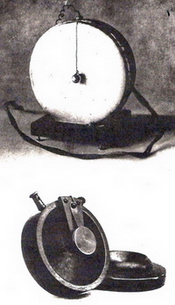
|
|
Simple. The "law" doesn't apply if one of the contacts is
in motion. That aspect of grandpa's telephone was the
missing link that Bell needed to make his own 'phone,
which was sound powered, practical. What Bell
adopted was the transmitter that incorporated battery
power which made possible long-distance telephony,
and an isolation coil that provided amplification while
preventing D.C. voltage from getting to the receiver.
For the sale of this innovation, Emile was paid
US$50,000 in 1878. He declined to take payment in
the form of Bell System shares. [He'd been warned that
Western Union would try to take over telephony.] Had
he done so, his stock, dividends added, would have
been worth One Billion Eighty-six Million Dollars at the
time of the Bell System breakup in 1984. Damn!
Sheet 2

|
|
I've shown Sheet 2 of the Telephone/Telegraph patent.
The dotted lines depict a tube connecting a mouthpiece to the transmitter enclosure (which Emile finally
called a microphone in patent 222,652 of 11 August
1879). P is the coil whose output feeds the receiver.
Emile's initial patent, applied-for June 4, 1877, was not
issued until Nov. 17, 1891 due to interferences by politicians. The Supreme Court, Mr. Justice Brewer presid-
ing, swept aside all interferences, ruling that Bell and
Berliner had done nothing to delay the patent's issuance, further that Emile Berliner was the sole and true
inventor of the microphone.
The toy-drum prototype grandpa used to confirm the
loose-contact principle is likely the one that's in Bell
Canada's archive. The loose-contact (variable resistance) microphone was used for a hundred years in all
the world's telephones. Today its century-old battery
power emanating from each "telco's" central office that still provides the necessary connection to the
world for places where power failures render current-day electronic handsets unusable during a power out-
age. A-men.
And if you fret that in a disaster your landline stops
working, let me tell you that the loss of service is by
decree of your "city fathers" who mistakenly believe
that residents must "stay off" the telephone exactly
when folks need it most, so that emergency personnel
will have clear circuits. Fact is, authorities' circuits are
generally not in the group serving affected areas and
first responders have always had radiotelephones and
never needed to use your lines. Telco landlines virtually
never fail...thanks to Emile Berliner's circuit design.
Emile Berliner
Courtesy of the Library of Congress
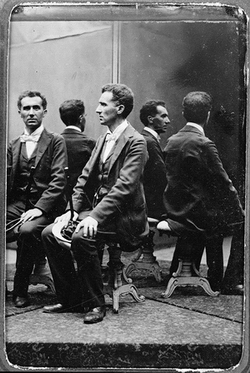
|
|
By the way, the U.S Patent Office has opined that its
'most valuable' patent is that of the telephone (by a
Canadian ex-pat), which converted sounds to electrical
pulses and "down the line" (distant) converted the electricity
back to audible sounds. And don't forget that the
Berliner telephone transmitter was the first device to
combine alternating current (sounds converted to electricity) and direct current (battery) in the same circuit;
besides being the first to pass current between electrodes that didn't contact each other.
The Greeks have a word for it.
Before I use any more of them, let's keep in mind (the
English language spelling of) the many Greek words
that have enjoyed common usage in our tight little industry.
telephone - distant sound
microphone - tiny sound
phonautograph - sound signature
phonograph - sound display
graphophone - display of sound
gramophone - sound of words
The Gramophone
I have always deplored the fact that many cognoscenti
used the phrase, "disc gramophone", when referring to
Emile's best known invention. But the truth is that in
his U.S patent of Nov. 8, 1887 is depicted (Fig. 1) a
cylinder recorder utilizing lateral cut. In this patent
Emile describes his method of mass-producing cylinder
records. As you can see, the recording is on a thin
sheet wrapped around a mandrel. For mass production, the sheet is laid flat and duplicated. You've no
doubt observed that with a wrapped original, or any
copy for playing it, there'd be a click over the joint every
time the mandrel made a complete turn. Fortunately,
grandpa never had to bother with such a cumbersome
and disappointing system - though for patenting, it did
the job. Phew!
But why wasn't the disc gramophone included in the
U.S patent? Simply because Emile was of the belief
that both Bell and Edison's experimentation with discs
(both inventors decided that the cylinder was superior)
precluded his getting a U.S patent. Ho ho.
Fig. 1
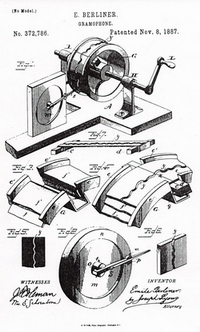
|
|
Fig. 8
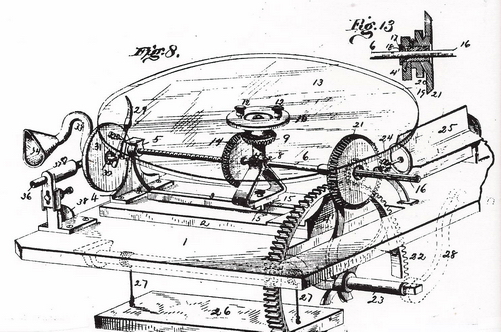
|
|
We don't get to learn of the disc gramophone until we
encounter British patent 15,232 of the same date,
where Fig. 1 shows the cylinder gramophone recorder/
player. Fig. 8 shows the disc recorder. Note that the
cutting stylus (29) is beneath the disc, allowing the
"chip" (stylus scrapings) to fall away. Emile specifies in
the text that the cutting should start at the inside of the
disc, thus avoiding chip-stylus entanglements. Inside-start was used in radio broadcast transcriptions for
decades, but not in 78s, 33s and 45s for the consumer. Radio transcriptions were sometimes cut vertically. RCA broadcast turntables incorporated a clever
velocity pickup cartridge...effectively a tiny ribbon microphone that tracked laterally- and vertically-cut discs.
Kämmer & Reinhardt Gramophone with metal base

|
|
Emile never recorded on the disc's bottom; but don't
forget that today's Compact Discs, DVDs too, have inside-start, are recorded on one side - the bottom, and
don't use paper labels. [Deutsche Grammophon introduced injection-molded 45s sans paper labels.] CDs
are also mass produced via the Berliner method of
1887...incredible and spectacular, don't you agree? I'd
like to apologize to those whom I disparaged. The
phrase disc gramophone is perfectly proper.
Emile's first Berliner Gramophone Co. was incorporated
in Newark, New Jersey in 1888 so that he'd have convenient access to the Duranoid Co., manufacturer of
large, fancy celluloid buttons for ladies' garments. The
buttons were stamped-out on a press, a process like
what Emile needed in his disc-making process. Discs of
celluloid quickly wore out; rubber discs changed shape.
The business collapsed as did the discs, though not
before grandpa was able to determine that a hot
"biscuit", principally of molten shellac from the Indonesian lac bug, met all requirements of record press and
record player. Now, if only Emile had had the capital to
go on...
Kämmer & Reinhardt Gramophone with wood base
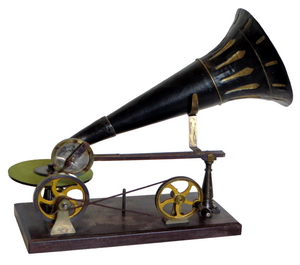
|
|
May I interject that I found in my father's collection the
oldest and rarest disc record in the world - a celluloid
pressing. It's now in the hands of Montreal's Musée
des Ondes Emile Berliner.
At a loss, Emile went back to the "old country" to visit
the world-famous dollmaker, Kämmer & Reinhardt.
Licensing was arranged for them to manufacture
125mm (5") children's records and the toy gramophones on which to play them. They'd be marketed in
Deutschland und England. Emile would produce master recordings for K&R, who'd also produce their own.
Out of this came gems in the Great Emile's still-German
-accented voice: "Twinkle, Twinkle Little Star" and "The
Lord's Prayer".
K&R's first gramophones were iron and weighed more
than a kid could lift. These gave way to a hand-cranked, figure-8 belt-drive unit that was lighter and
prettier. Horns were of gaily painted papier mache'.
The surviving image of Nipper
from "The Story of Nipper"

|
|
Later, many full-size "figure 8" gramophones (with
metal horn) would enjoy great market acceptance. Because the first production gramophones were for kids,
hearsay among some of today's collectors mistakenly
infers that Emile had created the gramophone as a toy.
Leaping ahead, I also must clarify (without detailing
today the innumerable things that resulted in
the 1901 formation of the Victor Talking Machine Co.
-a long story, as the reader is well aware), that
grandpa did not own nor control the Philadelphia company that bore his name. He'd gotten the long-sought
financing from Thomas Parvin who thus owned 90% of
the firm and ran it, with Emile owning 10% and relying
on patent licensing fees for his compensation. Upon
acquisition by the newly renamed Victor Company,
Emile received Victor shares but played no role in Victor's activities. Parvin got shares and became a Victor
director but not an officer.
It was Emile Berliner who in 1893 trundled over the
bridge of the Delaware River that linked Philly to Camden, New Jersey where he found a struggling machinist
who would create a clockwork motor to power the hand
-crank gramophone. By the time of his retirement at
the end of 1925, Eldridge Reeves Johnson had, in true
rags-to-riches fashion, become one of America's richest
men.
Eldridge Johnson renamed his Consolidated Talking
Machine Co. as Victor to associate the new company
with Emile Berliner's court victory. Confusingly, prior to
the "reorganization" he'd released a record under the
Victor label, named after Victoria, wife of an executive,
a record producer who'd recently joined Consolidated.
E.R.J. called his record players talking machines as he
didn't want to use Emile Berliner's word, gramophone.
The ultimate result of this decision was that in France
and the Americas, gramophones were mistakenly called phonographs. Damn!
"His Master's Voice"
Canada's vastness required the Victor
Company to establish a distribution centre
in Toronto. My father chose to name it His
Master's Voice, Ltd. The new factory that
opened on Lenoir St. in Montreal in 1908
boasted an enormous rooftop sign depicting the world's most famous trade--mark,
seen in a charming 1912 photo. When
launched 1 Jan. 1900, the Berliner Gramophone Co. had pressed records in space
rented from Canadian Bell Telephone Co.
The new facility included a railway siding
where boxcars were loaded with records
and gramophones for shipment to points
north and west. Lenoir St. is now the home
of the Berliner museum. The sign saluting "His Master's
Voice" is long gone. The loading dock and railway
tracks have survived.
The new factory that opened on Lenoir St. in Montreal in 1908

|
|
In year 2000 I picked up CARAS' (Canada's recording
society) award to the Great Emile for his founding of
the country's recorded music industry a century earlier.
I was brought to tears when the audience rose to honour the great man.
From the moment it became a trade-mark, a never-
ending rumour had it that artist Francis Barraud had
depicted the dog, Nipper, sitting on his late master
Mark Barraud's coffin, listening to a recording of
Mark's voice. Today I'm convinced that it truly was a
coffin that Francis had shown - but he thought better of
admitting it. Of course, we know that the dog-with-gramophone was a figment of Francis' imagination;
further that Mark never made a recording.
"His Master’s Voice" painting by Francis Barraud
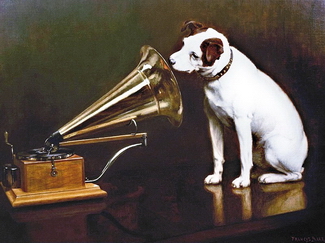
|
|
It wasn't long after "HMV" had achieved renown that
Francis was accused of copying a photo allowing him to
"remember" Nipper's countenance with such great detail after the dog had been dead some three years. To
sidestep the accusations, he destroyed all photographs
of Nipper...save one: the plate he reversed to make a
print with Nipper facing in the proper direction for his
purposes. "The Story of Nipper..." contains this image -
printed the way it was meant to be.
Francis was years later asked to make as true a copy
of his work as possible, to substitute for the original
which would be hidden away in times of stress. Known
as the "Chinese copy" for its faithfulness to the original,
it was long, long afterwards sent by Gramophone Co.
successor EMI to hang at its Capitol Records subsidiary
in Hollywood. Now EMI itself is gone.
When I saw it, the painting (faithfully revealing the
painted-over Edison-Bell cylinder mandrel and so indistinguishable from the original that it had to be marked
COPY) had special glass over it for protection, as it
hangs in a hallway. EMI eventually made spectacular
lithographs of the painting which the photographer was
asked to shoot in such a way that the overpainting
could be readily seen in the prints.
Francis was also commissioned to make 24 identical,
smaller copies of the original (sans the over-painting).
Bought by Gramophone Co. and Victor Talking Machine
Co., one went to Emile Berliner. As I believe grandpa
brought his model microphone with him to Canada, I
believe he also brought his painting and that his son,
Herbert absconded with it. Herbert and Emile had been
having disagreements over the course the company
should take. On Emile's 1919 visit, Herbert struck his
father, knocking him down.
Oliver Berliner

|
|
Right then, Herbert left the business and was never in
contact with his father or brother again. He spent full
time at his - Decca
Records distributor -
Compo Co. which he'd
formed to compete
with
the
Berliner
Gramophone Co. that
he'd headed. Edgar
succeeded him - in
1924 selling the Company to Victor, becoming president of Victor-
Canada, later of RCA
Victor-Canada.
Emile never completed
those
1919
experiments
in
im-
proving the quality of
disc
mastering.
He
immediately departed
the last vestige of his
companies, as well as
the record business
itself. The remainder of his life was spent solving public
-health issues. He died at 78 at home in Washington, D.C. On August 3, 1929 RCA's National Broadcasting Co. held moments of silence over the network to
signal the passing of Emile Berliner.
Herbert Berliner, his wife Jessie Kerr, and daughter
Katherine
(born,
Montreal
30
Dec.
1915) are all dead.
But where's grandpa's
painting? My guess is
that Katherine's child
or grandchild has it.
Who and where is
that person? Continuing is my $1,000 offer
to anyone who locates the painting.
I hope I've here shed
some light on the
many
mystifying
clashing
concepts
we've long endured;
and that I haven't
made things worse.
Thanx-fer-listnin'.
Ed. note: Berliner established his (second) gramophone
company in Philadelphia for easy access to fotoengraving
inventor Max Levi. Emile used Levi’s process in disc pressing
for "etching the human voice".
|